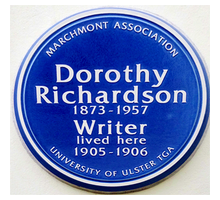 Almost two years ago, I embarked upon my most ambitious and, it turned out, most rewarding reading task, working through the thirteen books of Dorothy Richardson’s Pilgrimage. (Richardson referred to it as a single novel and each book as a chapter.) At the time I wrote:
Almost two years ago, I embarked upon my most ambitious and, it turned out, most rewarding reading task, working through the thirteen books of Dorothy Richardson’s Pilgrimage. (Richardson referred to it as a single novel and each book as a chapter.) At the time I wrote:
… while a complete scholarly edition of Richardson’s work may become available ten years from now, today the situation is little better than it was fifty years ago, when Louise Bogan wrote, “Merely to get at Dorothy Richardson’s novels … has, of late, become so difficult that the waning of her reputation may be partly put down to the absence of her books themselves and data on their author.” The best complete edition, issued in four volumes by J. M. Dent in 1967, goes for $250 and more, if you can find it. For about $50, you can assemble the four paperback volumes issued as Virago Modern Classics in 1979, but they tend to be “well read” copies. There was also a cheap paperback set published by Popular Library in the U. S. in the 1970s, but it’s more of a wreck than a reference.
I also provided links to free electronic editions of the first seven books, courtesy of the Internet Archive. However, browsing through the archive recently, I discovered that twelve of the thirteen books are now available, thanks to the Digital Library of India, which scanned in the 1938 edition published by J. M. Dent:
- Volume 1, which contains Pointed Roofs, Backwater, and Honeycomb
- Volume 2, which contains The Tunnel and Interim
- Volume 3, which contains Deadlock, Revolving Lights, and The Trap
- Volume 4, which contains Oberland, Dawn’s Left Hand, Clear Horizon, and Dimple Hill
If you want to undertake your own pilgrimage through Pilgrimage, you will still have to supplement these with Volume 4, either from the 1967 Dent hardback or from the Virago Modern Classics paperback editions, which includes the posthumously assembled thirteen novel, March Moonlight.
This is a good place, by the way, to mention that anyone who has benefited from the access to free electronic texts provided by the Internet Archive should take the opportunity to donate to its continued support.
Now for the technical note. On occasion, I get asked what e-reader I use, given the number of books I’ve covered from the Archive. I started out with a Nook not long after Barnes and Noble released the first one in 2009, primarily because it was the cheapest one, and then moved to a Kindle a year later because I was given one. Both had black and white displays, which were fine for books in EPUB/Kindle formats but lousy or useless for PDFs.
And this, for me, has always been the biggest drawback in using either to read material from the Internet Archive. Although virtually all texts on the Archive are available in formats compatible with e-readers, virtually all of these are also unedited outputs from optical character reader (OCR) scanners, which means they’re full of typos and page headers, footers, and other extraneous material. If the original text in the scanned book is clear and the person doing the scanning careful, these distractions are tolerable, but in too many cases, the output is just too difficult or tiresome to read in text format.
Because of this, I gave up on e-reading entirely for a while. But the thought that there were so many good books that I could access for free (and by now, the space that physical books take up is almost more of a concern than their cost) kept nagging me. When a friend showed me a PDF document on an iPad, I was tempted to go the Apple route, but cost and my concern for compatibility with my otherwise Windows-based household stopped me.

I finally found the happy solution after looking at a few Android tablets. I bought a used Lenovo 10″ tablet for about $110 and after trying out several different PDF readers settled on Xodo. I’ve been using this for over a year now and am completely content with it. The tablet is both big enough and small enough for comfortable reading, the display and size make most PDFs look much like the original printed page, and Xodo is very easy to use for annotation and highlighting. I’ve also moved my e-book files to Calibre which, when combined with a cloud-based storage service, gives me the ability to access my e-library from anywhere on the Internet. With the right plugin, Calibre also allows access to the locked PDF format used by the Open Library.
While I still prefer a real book to an e-book, the advantages of the 10″ tablet, a good PDF reader, and Calibre have definitely increased the proportion of e-books in my reading to a steady 25 to 30 percent, and I can highly recommend this solution to anyone who’s still on the fence about getting into e-reading.
